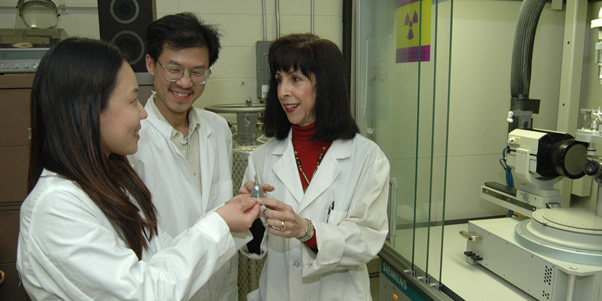Good Connections
Consortium of Universities Share High-Tech Equipment Via Cyberspace
January 20, 2009
By Russ L. Hudson
Equipment and instruments with names that sound as if they come from a Star Trek movie are available to students and faculty conducting research at Cal State Fullerton.
X-ray diffractometers, atomic force and scanning electron microscopes, an inductively coupled plasma mass spectrometer, a visible/near infrared spectrometer and circular dichroism spectropolarimeter are all available for use — not necessarily on campus but via the Internet through the California Partnership for Remote Instruments to Study the Structure of Matter, or Cal-PRISSM.
PRISSM, created and directed by Katherine Kantardjieff, professor of chemistry and biochemistry, aims to improve educational quality and student opportunities at the undergraduate and high school levels in learning about and researching molecular structure through the use of specialized scientific instruments made available via the cyber infrastructure. Cal State Long Beach, Cal Poly Pomona, Cal State Stanislaus, and Stanford University joined Cal State Fullerton in the PRISSM collaboration, each making high-tech equipment available.
PRISSM members design, use and assess learning programs and simulations that address California State University’s Programmatic Student Learning Outcomes and the California Science Content Standards with regard to various aspects of molecular structure. Both the learning outcomes and content standards are measurements of teaching effectiveness and best practices and will help PRISSM participants continually refine their teaching methods.
The Boeing Co. has supported the effort. An initial $13,000 grant in 2007 funded PRISSM's efforts to train high school teachers to use the remotely accessed instruments and to provide them with laptop computers and liquid crystal display projectors to do so.
Boeing provided another $45,000 in 2008 to PRISSM and Cal State Fullerton's College of Education for Southern California Science Education Collaborative/Promoting Resources in Informal Science Education program. Under the program, PRISSM, Tucker Wildlife Sanctuary and Fullerton Arboretum work with such science institutions as the Ocean Institute in Laguna Beach and the Discovery Science Center in Santa Ana. The premise is that making it easy for area science teachers to access rich sources of information will make their teaching better.
“Our goal is to improve science teaching and learning across multiple grade levels by promoting partnerships between Cal State Fullerton, informal science institutions and local schools in Orange County,” said Amy Cox-Petersen, professor of elementary and bilingual education.
“Dr. Kantardjieff has the experience and expertise to create ongoing partnerships with local schools and promote the use of specialized scientific instruments online,” Cox-Petersen said. “PRISSM will connect scientific data with the research, exhibits and other activities offered within the College of Education, the Ocean Institute, the Science Center and Tucker.”
Kantardjieff expects PRISSM to annually reach more than 1,600 students from kindergarten through 12th grade, community college and university, as well as faculty researchers.
“PRISSM’s share of the grant will be used, in part, to pay teachers summer stipends to come and work with us, to become really adept in the use of the cyber infrastructure and its potential,” said Kantardjieff. ”If we support the teachers to work with us for a month, they won’t have to teach summer school and miss this opportunity,” Kantardjieff explained. “We’re arranging for them to receive in-service credit, too, for learning those skills.”
This is not Kantardjieff’s first foray into putting high-tech instruments online so they can be shared. She put the X-ray diffractometers, the computational laboratory and other instruments that are part of the W.M. Keck Foundation Center for Molecular Structure online for all CSU campuses to use in 1997 and considers her work in the center the fertile ground from which PRISSM sprang.
As founder and director of the Keck Center, Kantardjieff garnered funding from various sources ranging from Keck, the National Science Foundation and National Institutes of Health. She approached Google to build a cyber learning community among participating students and to obtain funds to bring high school student scholars to participating PRISSM laboratories to work in teacher-student teams.
“The cyber learning community will capture what is being learned and how so that every student can benefit,” she said. “Another thing we’re arranging is for the high school teachers to attend professional conferences to make presentations about PRISSM. It will be far more effective for them to make the presentations than us, because they will have experienced it.”
Kantardjieff also intends to recruit high school educators to train less experienced teachers in remote instrument access and PRISSM best practices.
While more and more science is being done around the world collaboratively via the Internet, “We need to teach some ‘soft skills,’ too,” said Kantardjieff. She added “like how to work with people when they are not face-to-face and communicate effectively in such an environment. Another thing is for them to use their remote access to these instruments creatively, not just be rote button pushers.”
“Remote data collection on crystals has been conducted through the Keck Center for several years,” the researcher said. Through the PRISSM program, soil and water samples have been sent to Cal State Long Beach for analysis from biology classrooms, as well as samples from chemistry and physics,“ and others have research plans in place. So this is here, it is already happening.”
Kantardjieff is faculty coordinator Academic Technology in the CSUF's Faculty Development Center, is vice chair of the U.S. National Committee for Crystallography and a member of the Stanford Synchrotron Radiation Laboratory Users Organization Executive Committee.


